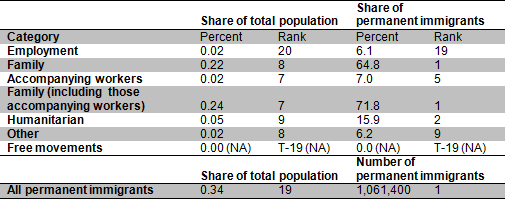U.S. is a World Leader in Family and Humanitarian Immigration, But Ranks Low in Employment Categories
Today, the Organization for Economic Cooperation and Development (OECD) released the International Migration Outlook 2013, which contains standardized statistics on permanent legal immigrants for 23 OECD countries and the Russian Federation. These statistics enable comparisons of how different countries prioritized different immigration categories in 2011. Among the 24 nations, the U.S. ranked first in total permanent immigration, but ranked 19th in permanent immigration as a share of its total population (0.34 percent).
In 2011 the U.S. was a world leader in immigration for family and humanitarian reasons, but fell near the bottom in employment-based categories. As a percentage of total immigrants, the U.S. was first among the 24 nations in the world in family-based immigration (64.8 percent), second in humanitarian immigrants (15.9 percent), and 19th in employment-based immigration (6.1 percent)*. Relative to its total population, the U.S. was eighth in family immigration (0.22 percent), ninth in humanitarian immigration (0.05 percent), and 20th in employment-based immigration (0.02 percent).
Table 1. U.S. immigration categories and ranks among 23 OECD countries plus Russia, 2011

Note: internationally standardized statistics may not exactly match national accounts. Percentages may not add to 100 due to rounding.
* Percentages of total permanent immigration were calculated from underlying data.
Share
Read Next
Support Research Like This
With your support, BPC can continue to fund important research like this by combining the best ideas from both parties to promote health, security, and opportunity for all Americans.
Give Now